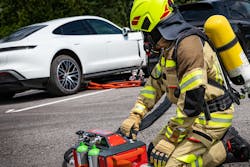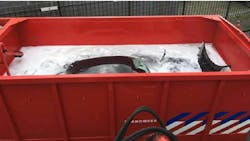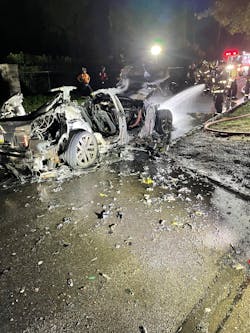Topic: Electric vehicle fire suppression
Objective: Understand electric vehicle fire suppression challenges
Task: The rescue team shall determine potential strategies, tactics and standard operating guidelines that are needed when dealing with fire suppression of an electric vehicle
As electric vehicles (EVs) become more prevalent, the chances of encountering an EV (or late-model hybrid) fire incident increase. Many challenges lie in store when an EV that has a high-voltage (HV) lithium-ion (li-ion) battery is involved in fire.
When HV batteries utilized nickel-metal hydride (NiMH) for their internal cells, as all of the early hybrids did, fire suppression was rather similar to what we expect from a burning internal combustion engine vehicle. For more than 10 years’ worth of hybrid vehicle fires, these original small, accessible HV batteries responded well to our conventional vehicle fire attack techniques.
Since the 2012 model year, most hybrids and almost all electric plug-in vehicles utilize a larger battery that has a li-ion cell chemistry. The li-ion cell chemistry along with high voltages, when compared with the NiMH system, result in a battery with more density. This gives an EV more range (distance that can be traveled between recharges). However, the li-ion chemistry results in radically different battery fire conditions. Li-ion should be considered a chemistry that doesn’t want to be messed with and that has the potential to not behave well when involved in a collision or fire event.
Fire suppression
It used to be that a vehicle fire was a vehicle fire. In today’s world, responders must be prepared to encounter either an HV battery-only fire, a vehicle and contents fire, or, potentially, both.
Fire suppression challenges come from the li-ion battery chemistry, the high-voltages, a large battery size and weight and, typically, a floorpan-mounted battery location. A department’s current fire suppression considerations, including strategies and tactics, must be reevaluated to ensure that they are up to date with this current technology.
For example, when arriving at an EV fire incident, responders could be confronted with two different yet related scenarios. In one, a li-ion battery-only fire is burning—meaning the fire is contained within the battery cells that are inside of the battery box.
A second scenario is a vehicle fire where the flames are consuming combustible materials inside and outside of the vehicle.
As responders become more aware of the challenges of EVs and, particularly, li-ion battery chemistry, three new prominent terms must be understood. Electrical engineers and government officials offer official definitions for these terms, but to make the terms make sense to us, we’ll define and explain these terms our own way.
Stranded energy refers to the electrical current (voltage/amperage) that remains inside of a battery even when its completely disconnected from everything else. Remember, many EVs use a 400-volt HV electrical system. (Porsche uses an 800-volt electrical system in its Taycan; startup manufacturer Lucid uses a 900-volt system in its AIR.)
When you think about it, stranded energy is something that we’ve known about after years of dealing with 12-volt low-voltage systems. The automobile’s 12-volt battery still holds stranded energy even after we disconnect or double cut the battery cables. We just didn’t call it stranded.
There’s stranded energy within each cell of the HV battery in an electric vehicle. Even with the EV’s power shut down or the HV battery physically damaged, it still has voltage within the cells, and it can keep this internal stranded energy charge for hours, days or even weeks.
Thermal runaway and off-gassing both relate to the degrading of the rechargeable cells that make up an HV battery as they go through a heating, short-circuiting or burning process.
Knowing that one li-ion battery in an EV can have thousands of rechargeable cells inside of the battery box helps us to understand thermal runaway. Think of setting up dominoes on end; after pushing the first one, the rest fall down in sequence. However, in an HV li-ion battery, there can be more than 7,000 “dominoes” in the form of battery cells, all tightly packed and connected together.
In the EV battery world, thermal runaway occurs when one cell shorts or otherwise overheats and melts, potentially catching fire. The cell overheat or fire condition passes to cells that are nearby. The chain reaction is thermal runaway.
Off-gassing usually occurs during thermal runaway and involves the production of smoke, usually grey or white in color, that issues from the battery. The smoke should be thought of as one of the steps in the thermal runaway process that potentially will result in the HV battery catching on fire.
EV fire tactics
Several unique tactics have been implemented by fire departments that were confronted with a burning EV.
TICs. Use of a thermal imaging camera (TIC) might reveal where the runaway heat is inside of the battery box. In contrast, use of a hot stick tool to determine where electrical current is or isn’t within the EV isn’t feasible, because the high-voltage current is direct current, which the tool isn’t designed to detect.
Extended duration firefighting. Results from a Fire Protection Research Foundation project as well as indications from real-world incidents show that when an EV and its li-ion battery are involved in fire, a longer than expected (sometimes hourslong) vehicle firefighting operation might be required. Because of this, on-scene supervisors are encouraged to anticipate that their initial attack team’s SCBA units will be depleted before all suppression work is done and that either replacement cylinders or relief personnel will be needed.Vehicle tilt/lift. It’s a reality that a floorpan-mounted battery limits access for fire suppression, which hinders members’ ability to fight the fire and to gain access to the battery. To address this challenge, one fire department’s tactic is to lift or tilt the EV enough so that cooling water can be concentrated on one area of the battery then moved to another area as the battery and the errant cells that are inside of it cool down.
Battery box piercing. In October 2021, fire apparatus manufacturer Rosenbauer launched its extinguishing system for li-ion battery fire suppression. The system punctures the battery box with a piercing-type nozzle. Water is then discharged through an attached hoseline, flowing directly into the battery unit itself. The company states that this tool allows for direct cooling of the battery modules or the cells that are within the modules and, thus, provides a quick stop of what the company refers to as the cell chain reaction—our thermal runaway scenario.
EV manufacturers are hesitant to recommend penetrating the battery compartment for any fire suppression effort.
Access during a battery fire plus the relatively low ground clearance can be yet other issues if a department were to utilize the Rosenbauer system.Copious amounts of water. Fire Protection Research Foundation burn tests revealed that battery reignitions are a real probability until the rechargeable cells are cooled sufficiently and the thermal runaway process is stopped. The group’s report, “Best Practices for Emergency Response to Incidents Involving Electric Vehicle Battery Hazards: A Report on Full-Scale Testing Results,” which is available at nfpa.org, includes many lessons learned, such as the need for copious amounts of water to extinguish a burning li-ion battery fire.
In one of the six full-scale li-ion battery test fires that the group carried out, researchers found that more than 2,600 gallons of water were required to extinguish the fire in an approximately 600-lb. li-ion battery.
Even EV manufacturers recommend that copious amounts of water are needed to be flowed onto the high-voltage battery for cooling to take place, potentially totaling 2,600 gallons or more.
As an EV tactic or a revision to your standard operating guidelines (SOGs), the recommendation is made that, in addition to water for initial knockdown, crews should set up so that copious amounts of water can be applied to the battery fire. Setting up for 3,000 gallons or more—including hitting a hydrant to create a sustained water supply—for a four-door EV fire is our new reality! If you can’t access this volume of water or you don’t have this amount of water available, you might have to go defensive.
Dunking: There have been several incidents in Europe in which a late-model hybrid or EV had an issue with its HV li-ion battery. As a solution, fire brigades that were involved resorted to “dunking.” Once the initial fire and flames were extinguished, the off-gassing vehicle, in a thermal runaway situation, was submerged in a tank of water for 24 hours.
Needless to say, this is a somewhat unusual way to ensure that copious amounts of water are applied.
Emergence of EV fires
Safety issues with HV li-ion batteries that are used in EVs gained the attention of U.S. authorities in May 2011 when a Chevrolet Volt spontaneously ignited and burned three weeks after it underwent a side-impact crash test. The li-ion battery was damaged physically in the crash test.
In 2013, in Kent, WA, a Tesla Model S caught on fire after it was driven over a metal object in the road that damaged its floorpan-mounted li-ion battery.
From that point to current times, incidents of EV fires, with or without crashes, have been documented around the world.
In November 2020, the National Transportation Safety Board (NTSB) completed its “Safety Risks to Emergency Responders from Lithium-Ion Battery Fires in Electric Vehicles” report and made the document available and downloadable for free on their website.
In the report, the NTSB investigated four EV fire incidents in great detail. From these, two major risks to responders were identified: electric shock from damaged HV electrical components and battery reignition after initial fire suppression because of uncontrolled increases in temperature and pressure (thermal runaway). The risks of electric shock and battery reignition/fire arise from the stranded energy that remains in the damaged HV battery.
All vehicle rescue training instructors as well as fire/rescue officers should be aware of and familiar with the contents of this safety report; it’s an outstanding, all-encompassing document that covers real-world incidents and several significant safety risks to responders. The safety report is NTSB/SR-20/01 and is available online.
A case study
An electric vehicle fire incident occurred on a residential street in Lower Merion Township, PA. The fire involved a recently purchased Tesla Model S that was being driven by its owner.
Through the cooperation of Chief Chas McGarvey of the Lower Merion Township, PA, Fire Department, Chief Thomas Hayden Jr. of the Merion Fire Company of Ardmore, PA, and the members of these two fire departments, we can review this fire incident and better understand the challenges that lie ahead for us when it’s our turn to combat a HV li-ion battery fire in an EV.
The quantity of water that was flowed through the two attack lines (both lines flowing initially, then one line continued to cool the battery) lasted for approximately 90 minutes. To suppress the fire, 20,000–23,000 gallons of water were used.
After the extended-duration fire suppression effort and aware of possible reignition issues because of stranded energy in the battery, the vehicle was towed by flatbed to the Lower Merion Township Public Works Department complex, where it was stored in an open area outside of any structures and away from any combustible materials.
Storing the vehicle more than 50 feet from combustibles is something that tow operators should be aware of and a procedure that should be incorporated into any SOG on EV fires. This protocol will bring your department actions and the storage facility operator in compliance with the Interim Guidance document that’s published online by the National Highway Traffic Safety Administration.
Besides maintaining safe distances from combustibles at the public works complex, local law enforcement authorities, made aware of the situation, also performed extra patrols of the storage area during the overnight period to monitor the status of the burnt vehicle.












